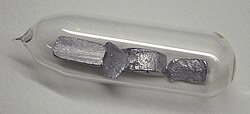Thallium
Thallium tends to oxidize to the +3 and +1 oxidation states as ionic salts. The +3 state resembles that of the other elements in thallium's group (boron, aluminum, gallium, indium). However, the +1 state, which is far more prominent in thallium than the elements above it, recalls the chemistry of alkali metals, and thallium(I) ions are found geologically mostly in potassium-based ores, and (when ingested) are handled in many ways like potassium ions (K+) by ion pumps in living cells.
Commercially, however, thallium is produced not from potassium ores, but as a byproduct from refining of heavy metal sulfide ores. Approximately 60–70% of thallium production is used in the electronics industry, and the remainder is used in the pharmaceutical industry and in glass manufacturing. It is also used in infrared detectors. The radioisotope thallium-201 (as the soluble chloride TlCl) is used in small, nontoxic amounts as an agent in a nuclear medicine scan, during one type of nuclear cardiac stress test.
Soluble thallium salts (many of which are nearly tasteless) are highly toxic in quantity, and were historically used in rat poisons and insecticides. Use of these compounds has been restricted or banned in many countries, because of their nonselective toxicity. Thallium poisoning notably results in hair loss. Because of its historic popularity as a murder weapon, thallium has gained notoriety as "the poisoner's poison" and "inheritance powder" (alongside arsenic).
Occurrence and production
Although thallium is a modestly abundant element in the Earth's crust, with a concentration estimated to be about 0.7 mg/kg, mostly in association with potassium-based minerals in clays, soils, and granites, thallium is not generally economically recoverable from these sources. The major source of thallium for practical purposes is the trace amount that is found in copper, lead, zinc, and other heavy-metal-sulfide ores.Thallium is found in the minerals crookesite TlCu7Se4, hutchinsonite TlPbAs5S9, and lorandite TlAsS2. Thallium also occurs as a trace element in iron pyrite, and thallium is extracted as a by-product of roasting this mineral for the production of sulfuric acid.
Thallium can also be obtained from the smelting of lead and zinc ores. Manganese nodules found on the ocean floor also contain some thallium, but the collection of these nodules has been and continues to be prohibitively expensive. There is also the potential for damaging the environment of the oceans. In addition, several other thallium minerals, containing 16% to 60% thallium, occur in nature as complexes of sulfides or selenides that primarily contain antimony, arsenic, copper, lead, and/or silver. However, these minerals are rare, and they have had no commercial importance as sources of thallium. The Allchar deposit in southern Macedonia was the only area where thallium was ever actively mined. This deposit still contains a loosely estimated 500 tonnes of thallium, and it is a source for several rare thallium minerals, for example lorandite.
The United States Geological Survey (USGS) estimates that the annual worldwide production of thallium is about 10 metric tonnes as a by-product from the smelting of copper, zinc, and lead ores. Thallium is either extracted from the dusts from the smelter flues or from residues such as slag that are collected at the end of the smelting process. The raw materials used for thallium production contain large amounts of other materials and therefore a purification is the first step. The thallium is leached either by the use of a base or sulfuric acid from the material. The thallium is several times precipitated from the solution and to remove further impurities. At the end it is converted to thallium sulfate and the thallium is extracted by electrolysis on platinum or stainless steel plates. The production of thallium decreased by about 33% in the period from 1995 to 2009 – from about 15 metric tonnes to about 10 tonnes. Since there are several small deposits or ores with relatively high thallium content, it would be possible to increase the production of it if a new application, such as a hypothetical thallium-containing high-temperature superconductor, becomes practical for widespread use outside of the laboratory.
| Symbol | Tl | |
| Atomic Number | 81 | |
| Atomic Weight | 204.3833 | |
| Oxidation States | +1,+3 | |
| Electronegativity, Pauling | 2.33 | |
| State at RT | solid | |
| Melting Point, K | 576.6 | |
| Boiling Point, K | 1730 |
Appearance and Characteristics
Harmful effects:
Thallium and its compounds are highly toxic. The average oral lethal dose is estimated to range from 10 to 15 mg of thallium per kg of body weight.
Agatha Christie made use of thallium’s toxicity in her novel The Pale Horse. One symptom the victims experienced, including one of the amateur investigators, was that their hair came out in clumps.
Characteristics:
- Thallium is a very soft, malleable, lustrous low-melting, silvery metal that tarnishes in air to the bluish-gray oxide.
- In appearance it resembles lead.
- The metal can easily be cut with a knife.
- In the presence of water, the poisonous thallium hydroxide (TlOH) is formed.
- Thallium dissolves slowly in hydrochloric acid and dilute sulfuric acid and dissolves rapidly in nitric acid.
Uses of Thallium
- Thallium sulfate, which is odorless and colorless, was used as a rat poison and as an insecticide. This use has been discontinued in some countries, including the USA.
- Thallium sulfide is used in photocells because its electrical conductivity increases on exposure to infrared light.
- Thallium oxide is used to make glass that has a high index of refraction.
- Thallium is also used in gamma radiation detection equipment.
